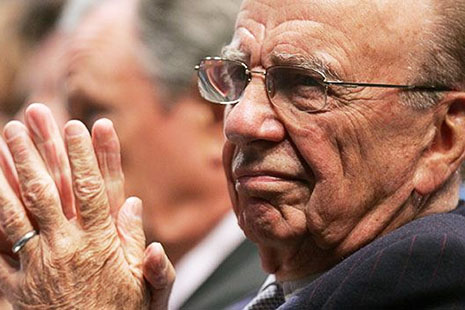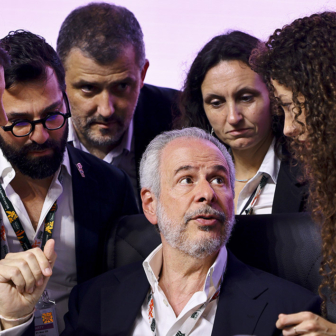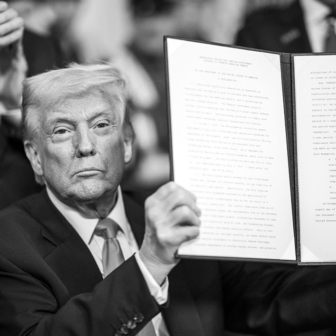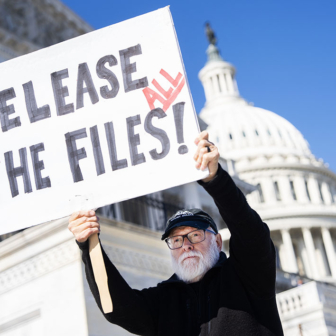Rupert Murdoch: An Investigation of Political Power
By David McKnight | Allen & Unwin | $32.99
Why Americans Hate the Media and How It Matters
By Jonathan M. Ladd | Princeton University Press | $36.95
THESE two entirely different books overlap in a crucial way, and in doing so increase our understanding of the current media and political climate, especially in the United States and to a lesser extent in Australia and Britain. The overlap concerns the rise of a strident, populist, right-wing element in the media. David McKnight describes News Corporation’s contribution to this phenomenon; Jonathan Ladd attempts to explain its part in what he shows to be a decline in the public standing of the media in the United States.
The great strength of McKnight’s book is that it collects and presents evidence of News Corporation’s covert as well as overt political activity, and shows how this politicisation has influenced the company’s news services in the United States, Britain and Australia.
His account proceeds on the basis that in pursuing these activities, the corporation is in many ways indistinguishable from its executive chairman, Rupert Murdoch: that even when he is not directly involved, the activities are undertaken because of a belief about what he wants or does not want.
According to this account, there are also many occasions when he is directly involved: meeting presidents and prime ministers and letting them know his preferences, funding enterprises designed to promote these preferences, putting pressure on editors. At one level, none of this is very different from what critics of Murdoch and News Corporation have been saying for decades. But McKnight’s singular achievement is to marshal evidence in a way that reveals the extent of these activities, and their effect on the Murdoch brand of news. In doing so he also reveals a systematic pattern of suppression, lack of transparency and hypocrisy.
The pattern takes several forms. One is journalistic misrepresentation. McKnight reports that in the lead-up to the 2004 federal election in Australia, for example, the Herald Sun, a News Limited newspaper in Melbourne, published an article headed “Greens back illegal drugs,” which claimed that “ecstasy and other illegal drugs would be supplied over the counter to young users.” The newspaper made other outlandish claims about the Greens, including one saying they would introduce laws to force people to ride bicycles more often and eat less red meat. The Australian Press Council upheld a complaint from the Greens, saying the article was irresponsible and made “a number of false claims.”
Years earlier, Murdoch’s New York newspaper, the Post, published a story about the likelihood that AIDS was spread by kissing, in the face of protests from the reporter that this was mere supposition. His London Sun suggested that only junkies, gays, bisexuals and victims of tainted blood transfusions could contract AIDS, and that anything else was “homosexual propaganda.” This misinformation was published at a time when much less was known about HIV/AIDS than is known now, and when public anxiety about it was high.
News Corporation’s newspapers have often engaged in baseless ad hominem attacks on individuals who have challenged its world view. One such instance recorded by McKnight concerned Clive Hamilton, whom the Australian accused of believing in a “vast corporate conspiracy to stall action on climate change.” Professor Hamilton has written extensively on climate change and climate-change denialism; the Australian has waged a persistent campaign against him and his views.
As late as 2009, the New York Post was editorialising that there was “growing doubt” over climate-change science. This was in the aftermath of the leaking of carelessly worded emails from climate scientists in Britain, who were subsequently cleared of any scientific malpractice. The paper’s Washington correspondent stated baldly that environmentalists wanted to “dismantle capitalism and bleed America dry.”
At the extreme end of the empire is Murdoch’s Fox News cable television service, which professes to present “balanced journalism.” McKnight assembles a substantial body of evidence in the form of memos, interviews and lists of those recruited to the service to demonstrate a deliberate strategy to create a conservative brand of politicised journalism masquerading as “balanced.” For example, the president of Fox News, Joe Peyronnin, described what happened when Murdoch appointed a Republican political strategist, Roger Ailes, to run Fox News. One of Ailes’s first acts, says Peyronnin, was to ask members of the staff whether they were liberal or not: “There was a litmus test. He was going to figure out who was liberal or conservative when he came in, and try to get rid of the liberals.” A system of briefings was instituted, in which the executive in charge of news, John Moody, would issue memos to Fox journalists dictating the political “line” to be followed for the day’s news coverage.
More worrying is Murdoch’s undisclosed funding of political enterprises that promote ideas and policy preferences he shares. In 2003 Murdoch donated $300,000 to an anti–affirmative action campaign in California and later attempted unsuccessfully to prevent the release of this fact through the courts. Also in the United States there was strong circumstantial, if not conclusive, evidence that he helped fund the clandestine activities of Brian Crozier, an anti-communist campaigner with connections to the British and US intelligence services. Crozier had a long history of anti-communist activism, including running a CIA-sponsored operation called Forum World Features, which syndicated right-wing articles to newspapers. In his autobiography, Crozier acknowledged his financial backers, including “Rupert,” subsequently identified as Murdoch by one of Crozier’s associates. In December 1990, the Guardian reported that Crozier’s publishing business, Sherwood Press, was bailed out by News International, Murdoch’s British holding company. News took a half-stake in the business and assumed liability for its debts, then said to total £90,000.
In Britain, Murdoch contributed an initial £150,000, and committed to a further £120,000 over three years, to the covert political activities of one David Hart, an adviser to Margaret Thatcher when she was prime minister. One of Hart’s ventures was a newsletter, British Briefing. A statement on its title page asked recipients to refrain from mentioning it or its existence. Edited by a retired British spy, it remained secret until 1989, when a copy was leaked to the Guardian. Hart and Crozier were also engaged as columnists for Murdoch’s Times. During the 1984–85 miners’ strike, Hart used his credentials as a Times correspondent to gain access to mining districts, and used that access to organise dissident miners against the mining unions. During this time, according to McKnight, he was reporting directly to Margaret Thatcher.
The impact of the company culture reached its apogee when it was revealed in July last year that News International journalists had been engaged in industrial-scale hacking of people’s mobile phones, including that of a missing schoolgirl, Milly Dowler, subsequently found murdered. When sprung, the company attempted a commensurately large cover-up.
Allied to this pattern is equally systematic hypocrisy. In Australia, Murdoch’s News Limited has been a driving force behind the Right to Know coalition, a group of twelve Australian media organisations with the stated aim of improving Australia’s “relatively poor world ranking for freedom of speech.” On the evidence presented by McKnight about Murdoch’s covert political activities, the public’s “right to know” does not appear to extend to the activities of Murdoch and News Corporation. Information about their covert funding activities has only been extracted by means of court action, leaks or unguarded statements by beneficiaries.
Moreover, Murdoch and News Corporation are meant to be in the business of journalism, which includes disclosing matters of public interest. The funding by a major newspaper publisher and television news broadcaster of partisan political activity in jurisdictions where they are also reporting on politics is a serious conflict of interest and clearly a matter of public interest. McKnight recounts several instances of Murdoch’s putting pressure on his editors to go easy on his political favourites, in particular Margaret Thatcher and Ronald Reagan. During Reagan’s presidency Murdoch told Thomas Kiernan, who was writing a biography of him, “The whole Reagan package needs much more support by the press.” On this view, it is the role of Murdoch’s newspapers to be a cheerleader for government – at least when it suits him. By contrast, when a public figure became persona non grata, as the actor Paul Newman did because of his opposition to the Vietnam war and support of progressive causes, he was simply banned from appearing in the New York Post.
All this would be bad enough if it involved some small-time media operation with limited power. In the case of News Corporation, however, it involves a vast multinational company whose head has had direct access to the White House, No 10 Downing Street, and the Lodge. One side-effect of the phone-hacking scandal has been to reveal the depth and breadth of Murdoch’s relationships with successive British prime ministers, especially Thatcher, Tony Blair and David Cameron. At the heart of these relationships was a set of reciprocating interests, political on the politicians’ side, political and financial on Murdoch’s. McKnight assembles a picture of these relationships which shows how reliant the politicians became, and how Murdoch played upon this in pursuit of policy preferences, especially those that might be financially advantageous to him.
Murdoch’s influence beyond the field of media and communications policy – in which he has a direct financial interest – is more difficult to pin down. He and his newspapers have claimed from time to time that they were responsible for certain election victories. Murdoch claimed to have broken twenty-three years of conservative government in Australia when he backed Gough Whitlam in the 1972 election that brought Labor to office, for example. But, as McKnight says, this was a fantasy. The biggest swing to Labor was in Victoria, where Murdoch owned no newspapers.
Three years later he was partisan in the opposite direction, supporting Malcolm Fraser, leader of the Liberal–National Coalition, after the dismissal of Whitlam by the governor-general in 1975. This time his partisanship went so far that even his own journalists went out on strike in protest. On this occasion – as in 1972 – public opinion polls clearly showed the direction in which the electorate was heading, and for Murdoch to claim the role of kingmaker has the appearance of someone claiming more electoral power than he really has.
But this is not to understate the effect on politicians’ minds of Murdoch’s perceived power. In the lead-up to the 1987 elections in Britain, McKnight reports that Margaret Thatcher said privately, “We depend on him to fight for us.” McKnight argues convincingly that it is this kind of leverage that Murdoch uses to pursue his policy preferences when his financial interests are at stake.
Outside the realm of media and communication policy, however, he seems to be less influential. He opposed US support for South African sanctions to no avail; he campaigned unsuccessfully against a law in New York forbidding discrimination against homosexuals; he campaigned unsuccessfully in favour of mandatory testing of prison inmates for AIDS; he railed unsuccessfully against the response by the US and British governments to the overtures from Mikhail Gorbachev during the period of glasnost that preceded the collapse of the Soviet Union.
McKnight’s book is a compendium of evidence about the methods of Murdoch and News Corporation in exerting influence. Unfortunately, the book is organised in a way that requires the reader to piece together the evidence across chapters. For instance, evidence about covert funding appears in chapters 1, 4, 6 and 8. Given the revelatory quality of this pattern of behaviour, and its importance to a full understanding of the Murdoch method, it would have added greatly to the book’s persuasive power to have it summarised in one place.
This convincing body of evidence makes the case about abuse of power without the need for polemics, which the author nevertheless relies on, not always successfully, as a significant persuasive instrument. In dealing with the issue of bias in Fox News, for instance, he reports that Murdoch infuriates his critics by pointing out that the channel regularly has guests who are Democrats, liberals and critics. The author adds: “The annoying thing is that this is partially true.” It is only annoying from a partisan viewpoint. There is a tendency throughout the book for this kind of partisanship to surface periodically, and it undermines its huge evidentiary strength. It is this strength that makes McKnight’s work stand out from all previous books on Murdoch, and it deserves to be required reading for anyone interested in politics, media and the interactions between the two.
THE development in the United States of a highly polarised media landscape, to which Fox News has made a significant contribution, is said to be a factor in the public’s declining trust in the media as an institution. In Why Americans Hate the Media and How It Matters, Jonathan Ladd examines this question from a political science perspective.
His line of argument goes broadly like this:
The existence of an independent, powerful, widely respected, professionalised news media establishment of the kind that reached its apogee in the United States during the middle of the twentieth century is an historical anomaly: it did not exist prior to the twentieth century and is now breaking down under a number of pressures.
These pressures include self-interested attempts by increasingly polarised politicians to undermine public trust in media that do not serve their interests, market demand for more partisan or entertaining styles of news, and increased competition arising from an internet-driven fragmentation of the media industry.
In response, the media has become more partisan itself and more given to sensationalism, which in turn is also undermining public trust.
Declining public trust causes further polarisation in the public as people fall back on their own ideological default positions. Here they are more resistant to new information from the media which might tend to make them moderate their positions, and increasingly seek out partisan news sources that confirm their pre-existing views.
In this way there is a self-perpetuating cycle in which distrust breeds polarisation which breeds more distrust.
To make this argument, he first subdivides the media into two groups: “institutional” and “alternative.” Into the first of these rather artificial categories, he assigns the main newspapers and the large television networks that have been the dominant sources of news for Americans for the past half-century. Into the second he assigns newer media outlets of different kinds: cable television, talkback radio and online platforms.
Ladd argues that from the 1960s onward, the political parties became more polarised and began to aggressively attack the trustworthiness of the “institutional” media. Simultaneously, as more “alternative” media outlets came on the scene, some “institutional” outlets began supplying more “soft” news in order to compete. These two factors led to a dramatic decline in public confidence in the media between the early 1970s and late 1990s. Concurrently, voters were increasingly sorting themselves more intransigently into Democrat or Republican camps.
After the abolition in 1985 of the Federal Communications Commission’s “fairness test,” which had required radio and terrestrial television to provide a balanced coverage of politics, talkback radio boomed. The most successful in this new gloves-off environment were conservative hosts such as Rush Limbaugh.
In cable television, the pioneering CNN, established in 1980, had a journalistic style similar to that of the “institutional” media, according to Ladd – professional, impartial, politically non-aligned news content separated from commentary. Fox News, when it began broadcasting in 1996, brought a more opinionated and conservatively partisan style similar to that of talkback radio. By 2004 its ratings were greater than those of the three other cable news networks combined.
Ladd presents survey data showing that opinionated cable hosts attract polarised audiences. By 2008, one of Fox’s most prominent conservative hosts, Bill O’Reilly, was attracting an audience 66 per cent of whom identified as conservative.
By the 1990s, a staple of conservative rhetoric on talkback and on Fox News was criticism of the “institutional” media as “liberal” – a swear word in the lexicon of the American right. As McKnight noted, “liberals” figure prominently on the list of Murdoch aversions, along with homosexuals, intellectual “elites,” adherents to “orthodoxy” and, above all, communists.
This dog-eat-dog attitude of one category of the media towards the other, combined with the disparaging of the media by elite political opinion and a more downmarket “tabloid” approach to news, are shown by Ladd statistically to be the main causes of the decline in public trust in the media.
This troubles Ladd – as well it might, given the central importance of the media to a healthy democracy – and he grapples with how it might be remedied. He acknowledges that it is impossible to recreate the conditions of the middle twentieth century, and also sees advantages in the newly fragmented and less professionalised media as agents of livelier and more open debate. His solutions, however, verge on the bizarre, especially given the attachment to market forces that partly defines what it is to be American: government subsidies for news organisations; a bigger government propaganda machine – which he gives the job of “directly publicising national conditions” – and the development of more not-for-profit news organisations.
There are some not-for-profit media already in the United States, especially in radio, and they produce some excellent material. But like Radio National in Australia, they serve a niche market and are not likely to be a significant brake on the decline in public trust which is clearly weakening the institutional standing of the American media.
There are significant parallels between these trends in the United States and what is happening in Australia. The rise of a strident, populist, right-wing talkback radio element in the media coupled with the clear pro-conservative political bias of the Murdoch press has polarised public debate and media coverage of politics to a degree not seen since the dismissal of the Whitlam government in 1975.
There is a large body of survey research showing that when the public perceives bias in the media, it trusts the media less. Therefore it would not be surprising if the patterns reported by Ladd in the United States applied also in Australia. •




